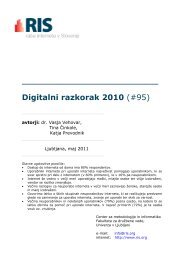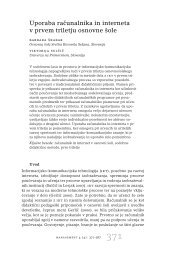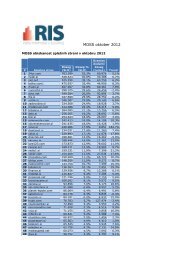the Labour Market Survey Report - Council of European ...
the Labour Market Survey Report - Council of European ...
the Labour Market Survey Report - Council of European ...
You also want an ePaper? Increase the reach of your titles
YUMPU automatically turns print PDFs into web optimized ePapers that Google loves.
5.3 Improving Validity <strong>of</strong> Estimates and Forecasts<br />
a) The IDC study asserted shortfalls for each country and “skill category” as <strong>the</strong> difference between<br />
<strong>the</strong> estimated demand and supply for that skill area. These are reported to be calculated as<br />
follows:<br />
• “Demand for ICT workers is estimated through a detailed analysis <strong>of</strong> numbers <strong>of</strong> IS<br />
departments, ICT-intensive business units, and numbers <strong>of</strong> companies in demand for IS<br />
support in <strong>the</strong> <strong>European</strong> economy, <strong>the</strong>ir size and evolution over time as a result <strong>of</strong> changing<br />
IS needs. Changing ICT skills needs and gap evaluation are also developed through close<br />
monitoring <strong>of</strong> ICT job-search sites, and unfilled positions over time”<br />
• “Supply <strong>of</strong> ICT workers is estimated through <strong>the</strong> assessment <strong>of</strong> two major important<br />
segments:<br />
- <strong>the</strong> number <strong>of</strong> current ICT workers available in <strong>the</strong> market (less average attrition rates);<br />
- <strong>the</strong> number <strong>of</strong> new ICT workers becoming available from university/college graduation,<br />
through re-training from o<strong>the</strong>r industry sectors or from o<strong>the</strong>r business units in <strong>the</strong> same<br />
company, as part-time workers from third party labour providers, as skilled and topmanagement<br />
workers from o<strong>the</strong>r industries.”<br />
According to <strong>the</strong>se definitions, it should be possible to reconcile <strong>the</strong> IDC figures for supply for<br />
past years with <strong>the</strong> actual employment levels. As indicated, <strong>the</strong> employment levels in <strong>the</strong> case <strong>of</strong><br />
<strong>the</strong> UK are around 50% <strong>of</strong> <strong>the</strong> asserted IDC figures for ICT workers. It is true that <strong>the</strong> UK figures<br />
used do not include non-IT occupations <strong>of</strong> any kind, and do not include engineers or technicians<br />
<strong>of</strong> a kind that would be employed in Telecommunications work (<strong>the</strong>y do not cover <strong>the</strong> “C” <strong>of</strong><br />
ICT). However, <strong>the</strong> non-technical occupations are not relevant to a study aimed at understanding<br />
possible skill shortages <strong>of</strong> IT occupations, and <strong>the</strong> (hardware) engineers and technicians are<br />
known to constitute a comparatively minor workforce (less than 10% <strong>of</strong> <strong>the</strong> IT occupation<br />
working population).<br />
b) Ideally skill shortages would be estimated directly, from reported hard-to-fill vacancies from<br />
a pan-EU survey <strong>of</strong> employers with <strong>the</strong> same questions and adequate samples conducted at<br />
<strong>the</strong> same time. In <strong>the</strong> absence <strong>of</strong> such evidence, it is almost impossible to make meaningful<br />
cross-country comparisons in terms <strong>of</strong> more detailed occupational categories. However, what is<br />
known about labour markets measured in a consistent way over a period is <strong>the</strong>ir growth. Thus,<br />
if a labour market for a particular occupation grows over a year by, say, 10,000, <strong>the</strong>n <strong>the</strong> number<br />
<strong>of</strong> people required in that year with <strong>the</strong> relevant skillset is 10,000 + <strong>the</strong> number who withdraw<br />
from that occupation during <strong>the</strong> year (<strong>the</strong> replacement demand arising from “attrition”). The<br />
additional supply each year in <strong>the</strong> future can <strong>the</strong>refore be estimated from <strong>the</strong> best forecasts <strong>of</strong><br />
growth, toge<strong>the</strong>r with an assumption about <strong>the</strong> replacement demand rate (normally expressed<br />
as a percentage <strong>of</strong> <strong>the</strong> total - “stock” - level). Since Eurostat holdings <strong>of</strong> Member State <strong>Labour</strong><br />
Force <strong>Survey</strong> data enable a relatively consistent measure <strong>of</strong> national levels <strong>of</strong> employment in<br />
each occupation, this provides a significantly more consistent and valid way <strong>of</strong> estimating future<br />
demand, against which policy responses can be considered. This approach inevitably depends<br />
fundamentally on <strong>the</strong> validity <strong>of</strong> forecasts, but <strong>the</strong> accuracy <strong>of</strong> <strong>the</strong> growth rates used in <strong>the</strong> IDC<br />
and Career-Space forecasts depend likewise on <strong>the</strong> reality <strong>of</strong> economic growth, in relation to that<br />
assumed.<br />
C E P I S I.T. PRACTITIONER SKILLS IN EUROPE | Section 5 | 75

















